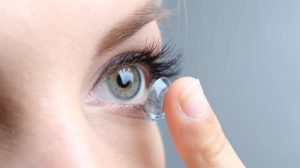In this article, we will learn about myopia, a common vision condition affecting billions of people worldwide, including causes, symptoms, complications, and treatments.

What Is Myopia?
If you have problems seeing objects or items from a far distance or you need to move closer to see them clearly, you probably have myopia or nearsightedness.
Myopia is a common refractive error condition. It’s been estimated that by the year 2050, about 5 billion people worldwide will be affected by it. The prevalence of myopia is particularly high in Asian countries: 80-90% of young Asian people are nearsighted.
Progressive myopia means the correction to see clearly increases by more than 0.5D per year. This form of myopia typically affects children and teens.
Causes
Usually, myopia occurs when the eyeball is too long. In a person with normal vision, the light rays enter through the pupil and are focused directly on the retina, giving a clear image. When the eyeball is too long, the light rays are focused in front of the retina, giving a blurry image.
In case of progressive myopia, the eyeball grows longer and longer as the child continues to grow, increasing the refractive error.
There is definitely a genetic component of myopia; children of parents with myopia have a much higher risk of having or developing myopia.
People of Asian descent have a higher risk of myopia.
An excessive amount of close-up tasks like reading, computer work or watching videos on one’s phone is linked to progressive myopia.
Recent studies show that children who don’t spend enough time outdoors (1.5 h per day) are also more likely to develop myopia.
Symptoms
A person or child may have myopia if they have the following symptoms:
- Blurred vision and need to get closer to see clearly
- Unaware of distance items or objects
- Excessively blinking
- Headaches or fatigue
- Persistent squinting
- Eyestrain
- Rubbing eyes frequently
Adults with myopia may experience vision difficulties when driving.
Children with myopia may complain about not being able to read or see what is written on the blackboard at school and feel like they need to sit closer to watch TV or lower their heads while writing.
Complications
What are the long-term effects of myopia other than the need to wear eyeglasses or contacts every day?
Health experts have pointed out that people with high myopia have increased risks of the following eye diseases:
- Cataracts
- Glaucoma
- Retinal detachment
- Macular degeneration
- Myopic maculopathy.
These above eye conditions can cause permanent vision loss if no action is taken. Therefore, regular eye exams are highly recommended to manage myopia and detect early signs of sight-threatening diseases.
Diagnosis
The first step in diagnosing myopia is a visual acuity test. Usually, this is done with a Snellen Chart. Your eye doctor will ask you to read the lines of letters decreasing in size till you can no longer read them.
Children may receive eye drops to eliminate accommodation and to objectively measure their visual acuity with the Snellen Chart
In case of progressive myopia, a regular biometry (ultrasound) will be performed to follow the increase in eyeball length.
Treatments
The most common treatment for myopia is a prescription for eyeglasses or contact lenses.
If you wish to get rid of myopia more permanently, refractive surgery such as LASIK, SMILE, or PRELEX is another option. These procedures are only recommended for adults with myopia that is no longer progressing. Otherwise, nearsightedness may make its way back, and you will need to wear glasses again.
During refractive surgery, eye surgeons will either replace your natural lens or use a laser to reshape your cornea, both allowing light to focus precisely on the retina.
An innovative and safe technique that has been developed and proven to help people with myopia — even children — see more clearly is Ortho-K (orthokeratology). Ortho-K corrects vision by using a rigid contact lens to temporarily reshape the curved cornea — similar to what dental braces usually do. The lenses are worn at night and removed in the morning, so you have clear vision during the rest of the day. Ortho-K does not correct myopia permanently. It only takes away the need to wear glasses or contacts during the day.
Treatment with daily Atropine drops can slow down the progression of myopia in children..
Prevention
Myopia can not be entirely prevented, but there are some good eye health habits to prevent progression and protect your eyes in general, like:
- Have regular eye exams
- Read or do near-focused tasks with good lighting and at a distance equal to the length of one’s forearm.
- Watch TV from at least 3m distance
- Outdoor activities for at least 1.5h a day
- Wear protective eyewear when playing outdoor sports
- Wear sunglasses to limit sun exposure
- Wear corrective lenses as directed by your doctor
- Rest your eyes with the 20/20/20 rule after using digital devices for a long time
- Adapt a balanced and healthy diet
- Quit smoking
- Exercise
- Keep your chronic conditions under control (diabetes, hypertension, and cholesterol levels)
If you experience blurry vision or eye strain, contact EEC today for an eye exam!
Every patient deserves top-quality eye care from us. European Eye Center focuses on providing Western-standard services and determining appropriate treatment plans to help patients restore their vision in a feel-like-home atmosphere.
We are happy to help if you have questions about myopia or other vision conditions. Don’t hesitate to connect with us at info@europeaneyecenter.com.
Contact us today to schedule an eye care service!







